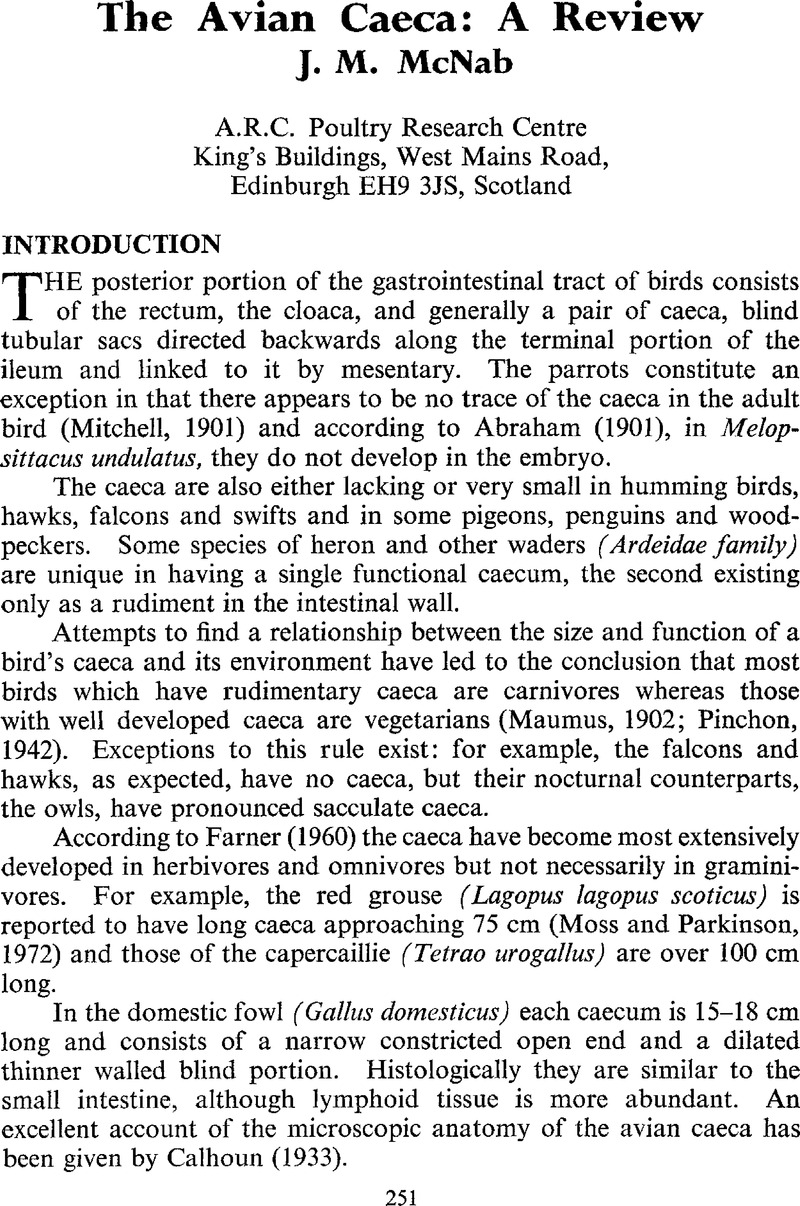Crossref Citations
This article has been cited by the following publications. This list is generated based on data provided by Crossref.
Witlock, Dale R.
1975.
SEM of the Cecal Morphology in the Domestic Chicken.
Proceedings, annual meeting, Electron Microscopy Society of America,
Vol. 33,
Issue. ,
p.
518.
Gentle, M.J.
and
Savory, C.J.
1975.
The effect of dietary dilution on the intestinal anatomy of the Japanese quail (Coturnix coturnix japonica).
Research in Veterinary Science,
Vol. 19,
Issue. 3,
p.
284.
Savory, C. J.
and
Gentle, M. J.
1976.
Effects of dietary dilution with fibre on the food intake and gut dimensions of Japanese quail.
British Poultry Science,
Vol. 17,
Issue. 6,
p.
561.
Proudfoot, F.G.
and
DeWitt, W.F.
1976.
The Effect of the Pellet Binder “Lignosol FG” on the Chicken’s Digestive System and General Performance.
Poultry Science,
Vol. 55,
Issue. 2,
p.
629.
Crompton, D.W.T.
and
Nesheim, M.C.
1976.
Advances in Parasitology Volume 14.
Vol. 14,
Issue. ,
p.
95.
McClure, Harold M.
Chapman, Willie L.
Hooper, Billy E.
Smith, Frederick G.
and
Fletcher, Oscar J.
1978.
Pathology of Laboratory Animals.
p.
175.
Clarke, P. L.
1978.
The structure of the ileo‐caeco‐golic junction of the domestic fowl (Gallus GallusL.).
British Poultry Science,
Vol. 19,
Issue. 5,
p.
595.
Clarke, Peter L.
1979.
Coccidial infection withEimeria Tenellaand caecal defaecation in chicks.
British Poultry Science,
Vol. 20,
Issue. 3,
p.
317.
Radlett, A. J.
1979.
Excystation of Notocotylus attenuatus (Rudolphi, 1809) Kossack, 1911 (Trematoda: Notocotylidae) and their localization in the caecum of the domestic fowl.
Parasitology,
Vol. 79,
Issue. 3,
p.
411.
DUKE, G.E.
EVANSON, O.A.
and
HUBERTY, B.J.
1980.
Electrical Potential Changes and Contractile Activity of the Distal Cecum of Turkeys.
Poultry Science,
Vol. 59,
Issue. 8,
p.
1925.
Clarke, P. L.
Crompton, D. W. T.
Arnold, Susan
and
Walters, D. E.
1980.
Caegal growth in the domestic fowl following surgical manipulation.
British Poultry Science,
Vol. 21,
Issue. 5,
p.
377.
Sudo, Sara Z
and
Duke, G.E
1980.
Kinetics of absorption of volatile fatty acids from the ceca of domestic turkeys.
Comparative Biochemistry and Physiology Part A: Physiology,
Vol. 67,
Issue. 2,
p.
231.
Duke, G.E
Bird, J.E
Daniels, K.A
and
Bertoy, R.W
1981.
Food metabolizability and water balance in intact and cecectomized great-horned owls.
Comparative Biochemistry and Physiology Part A: Physiology,
Vol. 68,
Issue. 2,
p.
237.
KESSLER, J.W.
and
THOMAS, O.P.
1981.
The Effect of Cecectomy and Extension of the Collection Period on the True Metabolizable Energy Values of Soybean Meal, Feather Meal, Fish Meal, and Blood Meal.
Poultry Science,
Vol. 60,
Issue. 12,
p.
2639.
Skadhauge, Erik
1982.
A quantitative survey of salt and water excretion.
Comparative Biochemistry and Physiology Part A: Physiology,
Vol. 71,
Issue. 4,
p.
481.
Rice, G. E.
and
Skadhauge, E.
1982.
Caecal water and electrolyte absorption and the effects of acetate and glucose, in dehydrated, low-NaCl diet hens.
Journal of Comparative Physiology ? B,
Vol. 147,
Issue. 1,
p.
61.
Duke, Gary E.
Eccleston, Eric
Kirkwood, Sam
Louis, Charles F.
and
Bedbury, Holly P.
1984.
Cellulose Digestion by Domestic Turkeys Fed Low or High Fiber Diets.
The Journal of Nutrition,
Vol. 114,
Issue. 1,
p.
95.
Raharjo, Y.
and
Farrell, D.J.
1984.
A new biological method for determining amino acid digestibility in poultry feedstuffs using a simple cannula, and the influence of dietary fibre on endogenous amino acid output.
Animal Feed Science and Technology,
Vol. 12,
Issue. 1,
p.
29.
Gremmels, H. -D.
1986.
Das Verdauungssystem der Rauhfußhühner — Eine Übersicht zur Physiologie und Mikroanatomie dieses Organsystems.
Zeitschrift für Jagdwissenschaft,
Vol. 32,
Issue. 2,
p.
96.
Ferrer, Ruth
Planas, Juana M.
and
Moret�, Miquel
1986.
Characteristics of the chicken proximal cecum hexose transport system.
Pfl�gers Archiv European Journal of Physiology,
Vol. 407,
Issue. 1,
p.
100.



